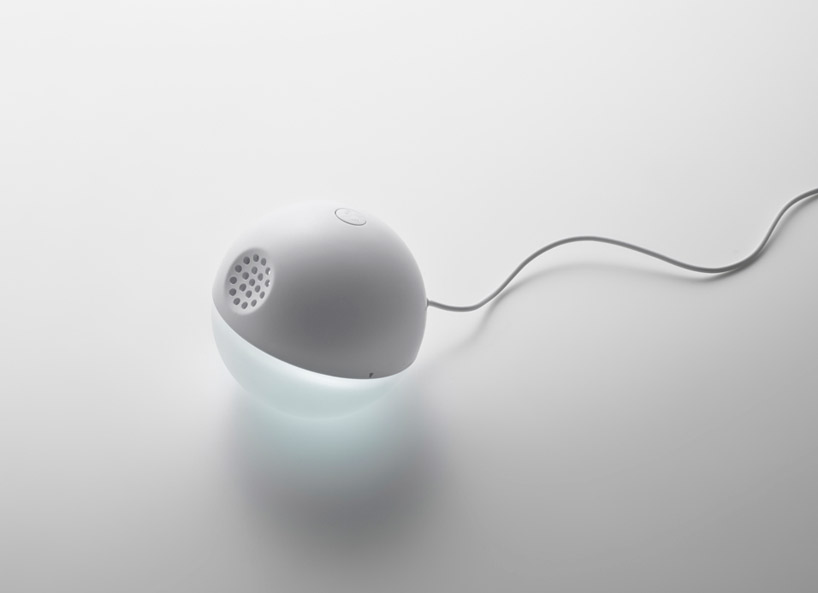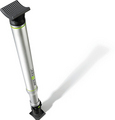nendo: air purifier for arobo
by: Designboom - Weblog, 2012-03-01 17:36:00 UTC

the orb-shaped air purifier harnesses the centrifugal force created by the revolving of water from the bottom to top compartments, sending vapor into the surrounding environment.
read more
Best Practices in Communicating about Sustainability
by: Environmental Leader, 2012-03-01 14:42:37 UTC

While sustainability initiatives have boomed in recent years, many companies are still seeking help in developing strategy and others are struggling with communication efforts. I’d like to offer some clarity and share best practices regarding sustainability as it relates to paper and allied industries. Companies that follow such best practices have proven themselves to be [...]
 Peravaes MonoTracer MTE 150 blends sustainability with performance
Peravaes MonoTracer MTE 150 blends sustainability with performance
by: The Design blog, 2012-03-01 06:52:53 UTC
Jaspreet Kaur Walia:
Electric vehicles are becoming a hot favorite and the soaring demand is a fine example of their popularity. Though these are not as speedy as the conventional rides, but are a great way to commute around the city without the fear of polluting it with poisonous fumes. Adding to the inexhaustible list is the Peravaes MonoTracer MTE-150, which is a cross between a motorbike and a car. It will smother senses with the excitement of a bike and endow the user with the comfort of a four wheeled vehicle.

Peraves MonoTracer MTE-150
Picture Gallery
Peraves MonoTracer MTE-150: Kevlar monocoque cabin cycle
Swiss company, Peraves won the Automotive X-prize and its time the sumptuous two-wheeler enters mass production that will let eco lovers savor what it offers. The vehicle is highly efficient and performance wise will intoxicate senses with all it has to deliver. The company upgraded drivetrain with a 3rd generation 150kW AC propulsion. The eye appealing vehicle can come up with 525 MPGe when driven at a constant speed of 45 miles per hour, which sure is impressive. But, users should expect nothing more than 350 MPGe as driving at a steady speed is not a very realistic thing. A display at the front will clearly put on show the speed plus the power being consumes as well as conserved.
The Peravaes MonoTracer MTE-150 will come fitted with a lithium polymer battery pack, which will produce energy worth 20kWh with an impressive range of 200 miles. If you are speed lover, then hold your breath as the beauty on two wheels can jump from zero to 60 mph in as less as 5 seconds. The inside is spacious and has ample legroom and headroom, lending the much required comfort. It comes fitted with a small set of wheels, which can be deployed by pressing a button on the left handlebar. These will prove to be of utmost help when one needs to stop as it is not possible to put the feet down to stabilize the ride. The MTE-150 will unfurl a comfortable riding experience, which comes tagged with efficiency and eco friendliness.
Via: Autobloggreen


 Hybrid human powered vehicles to transform future transport
Hybrid human powered vehicles to transform future transport
by: The Design blog, 2012-03-01 13:32:25 UTC
Asmita Prasad:
The concept
In the recent years, auto manufacturers and common folks have started to take hybrid automobile technology more seriously and various government agencies and local municipalities around the world have responded to the green movement by enforcing a new system of taxation where hybrid vehicles, all-electric vehicles and human powered vehicles have been subjected to various kinds of tax exemptions to promote their use among common people. Though EVs and hybrids are nothing new to us, a new kind of hybrid vehicle called a human-electric hybrid vehicle, however, is still news to the masses. That being said, the technology behind this new breed of green vehicles is nothing new though its application in this new form has surprised many people. In layman’s terms, a human-electric hybrid vehicle is basically something like a human-powered vehicle (e.g., a bicycle) that has the capacity to use an electric motor/generator to turn human effort into electricity that can be stored in batteries for use at a later time or can be used directly to run an electric engine that can propel the vehicle when the user is not pedaling.

Hybrid human powered vehicle
The Inspiration
Harvesting human kinetic energy to power a vehicle or part of it is again not a new concept. Right from the first bicycles, harvesting good old human power has provided an immediate solution to various mechanical challenges and fuel limitations. In a world that is fast running out of fossil fuel, these alternate methods are becoming mainstream again and designers are investigating the possibilities for widespread and feasible applications for human powered or human-electric powered hybrid vehicles. Early examples of the use of human power to jumpstart a vehicle or even provide occasional assistance to engine-run vehicles came into being as early as 1897 when inventor Hosea W. Libbey created a parallel hybrid motorized bicycle. By the early 20th century, motorcycles like the 1912 Douglas that used pedals to provide a jumpstart to the vehicle arrived on the scene. Mopeds and auto cycles that evolved from such improvements gained popularity in the 1990s with the British made Cyclemaster and Czech made Jawa. Though these low-powered two-wheelers still exist today, the human-electric hybrid vehicle is a further improvement on the same technology that replaced the fuel-run engine with an electric motor and batteries.
Eco Credentials
A human-electric hybrid vehicle would be the ultimate zero emissions vehicle, which would have a zero carbon footprint. Unlike most electric vehicles that need to be recharged using grid power (given the state of photovoltaic we are discounting them as credible sources of alternate electric power) that in turn is mostly made from coal or other fossil fuels, the HEHV would be powered solely by the electricity a rider generates. Generating electricity on demand and using it as and when needed, these vehicles would ensure minimum wastage of grid power and one wouldn’t have to wander about looking for EV recharging stations or wait around for vehicles to attain a decent charge to be able to use them. The HEHV would thus be the ultimate, grid-independent, green personal mobility solution that can be adopted by the masses with ease.
What makes them stand out?
Since a HEHV would typically carry a small electric motor and battery, they will also be potentially chargeable via low-output alternate power sources like windmills and solar panels when the user wants to run it in electric only mode. Disposing of high storage density batteries with limited life that are used with all-electric vehicles and environmental effects of power distribution and electricity generation need to be taken into account when calculating the actual “greenness” of current EVs. By that standard, most current EVs and hybrids aren’t exactly zero emissions which makes a great case for the HEHV since the latter only relies on human power to generate electricity needed by it.
Feasibility
Using the same model of calculation that Scottish inventor James Watt used to derive the “horsepower” of the steam engine (a term that is still used to measure the output of a machine or engine), human kinetic power too can be calculated. One unit of Watt’s original horsepower equaled 745.7 watts. To measure the horsepower that human beings can sustain over time, we can use a cycle power meter (like the one used by Tour De France cyclists) to measure the amount of power a human being can actually produce via their own efforts when supplemented by a mechanical aid like the pedal-chain-and-gear of a bicycle. By the estimates put forward by Cycling Power Models, over 450 W are produced by elite cyclists over a one hour journey and a healthy amateur cyclist can generate about 200 W in the same time. Judging by these figures, a human-electric hybrid vehicle is not only tremendously feasible as an individual commute option used by the masses but also incredibly easy to manufacture and use. By simply mating this kind of human effort with an efficient electricity storing battery and an equally efficient electric motor, a human-electric hybrid vehicle can be produced that would be an appealing zero-emissions green vehicle that wouldn’t need to rely on grid power or solar/wind power to recharge.
Related trends
1. Human Car

Human Car
The Human Car manufactured by a Seattle-based company of the same name, is a vehicle that uses the principles used to propel a tandem railroad trolley to drive a human driven four seater four wheeler. Costing $15,000 each, the Human car weighs 400 pounds and is made of aluminum and carbon fiber. The push-pull hand mechanism of the Human Car makes it a feasible human-power only vehicle concept though it can practically be used only in shared use and community use vehicles.
2. NoVelo human-powered vehicle

NoVelo human-powered vehicle
Created by a University of South Australia student named Tim Turrini-Rochford, the NoVelo is a HEHV that comes with a built-in 300W hub motor. The vehicle is based on the classic velomobile and can hit a top speed of 50kph.
3. Trimtab 3X3

Trimtab 3X3
A collaborative effort between Stress Engineering Services and Losantiville Kunstwerkhaus, the Trimtab 3X3 was conceived by designer David Parrott. The vehicle comes with flatbed storage adaptable nylon seating and skins and a canopy for all season use. The electric assisted recumbent tricycle is basically a 3×3 vehicle with two 3hp electric motors powered by dual 50ah batteries that are recharged by human effort.
4. Road Star-S hybrid human-electric urban utility vehicle

Road Star-S
Powered by an electric motor and pedal power, the Road Star-S is a light utility vehicle that uses a lithium polymer battery, a 400 W electric motor and good old leg power to ferry the driver and a friend around the city.


 Tasty, Sustainable Tacos with Manila's First Designer Food Truck
Tasty, Sustainable Tacos with Manila's First Designer Food Truck
by: Core77, 2012-03-01 01:00:00 UTC
 Guactruck is Manila's first designer food truck.
Guactruck is Manila's first designer food truck.
They're a staple in New York City, Portland and much of California, turning up in urban centers across North America by the day (at least come summer time): colorful, designer food trucks hawking delicious street food from around the world, from Korean tacos to crispy falafel. Multiple trucks park outside the Los Angeles County Museum of Art on Wilshire Boulevard, and near the startup hub of San Francisco's Mission Street.
Now, the designer food truck phenomenon has spread its wings to the busy streets of Manila, Philippines. Started by Michealle Lee and Natassha Chan, Guactruck opened business recently as the country's first designer food truck. It wasn't easy, they tell me.

"In the first month, most of our customers were foreigners," said Ms. Lee, who hatched the idea after a stint living in Los Angeles to study business. "The Pinoys [Filipinos] were intimidated, even with free samples."
In the spirit of LA's many fusion restaurants, Guactruck provides Mexican-style Filipino dishes. Taking a page from Chipotle's playbook, they offer a build-your-meal plan along a buffet-style assembly line, with everything from soft tacos to burrito bowls stuffed with you choice of delicious Filipino dishes like pork adobo, chicken tocino and garlic rice. The tasty, unexpected blend partly reflects Guactruck's roots in Southern California, which has a rich Filipino and Mexican community.
 Guactruck's food is all sourced from local businesses, thus substantially reducing the company's carbon footprint in an island nation.
Guactruck's food is all sourced from local businesses, thus substantially reducing the company's carbon footprint in an island nation.
"It's hard to find Mexican ingredients," Ms. Chan noted. "We made sure the food is more Filipino, prepared in a Mexican style."
This practical business decision—to use authentic, accessible ingredients—dovetails with their abiding interest in sustainability. All of the food is locally sourced, which drastically reduces their footprint in an island nation where much of the food is shipped in from overseas.
Beyond cuisine, Ms. Lee and Ms. Chan aim to innovate with sustainable business initiatives. The truck, a retrofitted Mitsubishi L300, is almost entirely self-contained and comes with LED and energy-saving lighting. They paid meticulous attention to the interior design to ensure all available space was maximized; only a generator sits outside to help power the truck during hours of operation.
 The interior is as thoughtfully-designed as the exterior
The interior is as thoughtfully-designed as the exterior
(more...)












Comments by our Users
Be the first to write a comment for this item.